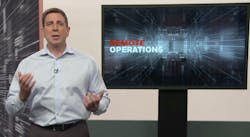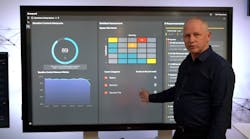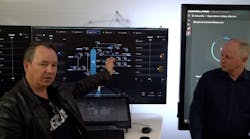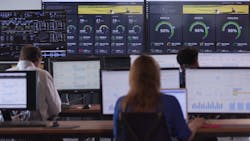Remote Technologies From Honeywell Enable Continued Operations
In the heart of the seasonal automation events, summertime usually means a visit to Texas for the annual Honeywell Users Group (HUG) meeting. Forced to move its event online amid the global pandemic, it seemed particularly fitting that Honeywell’s main keynote this year focused on remote operations.
Indeed, remote operations of all kinds—remote sales, remote troubleshooting, even remote commissioning and factory acceptance tests—have become more prevalent as manufacturers figure out how to either continue operating or restart operations while keeping their employees and customers safe from COVID-19.
“One of the our most immediate challenges during the crisis was to maintain the health and safety of employees” while also keeping business levels up, commented Jason Urso, chief technology officer for Honeywell Process Solutions. “How could we assure that we’re providing the levels of support to address our customers’ needs while at the same time addressing the health and safety of our personnel?”
At this year’s Honeywell Virtual Technology Experience (VTech), Urso and his team introduced several new products based on addressing operational needs remotely. “They’re highly oriented around what we call a new way of working,” Urso said. “They came to us out of necessity during the crisis.”
These are technologies that Honeywell had already been working on for quite some time—particularly for applications like mining or wellhead operations, which have hundreds of distributed assets. “For these industries, remote operation is typical; it’s required, in fact. And we’ve been supporting these industries for many years,” Urso commented. As other industries find themselves in crisis needing to spread out their personnel, there’s been more demand across the board. “It’s become apparent that remote operations are very applicable to everyone.”
Remote operations
In fact, Honeywell faces the same sorts of needs as its customers in its own plants. It was at its own chemical plant in Orange, Texas, that Honeywell first rolled out Experion PKS Augmented Remote Operations (ARO), introduced by the company in March. “It extends the control room to other facilities at the site, and even backup facilities for remote support,” Urso explained, commenting on how quick and easy it was to get the fully functional operator consoles up and running. “The cybersecure ARO offering only requires a server, firewall configuration, and a couple hours of your time.”
Installation was seamless, according to Christine Craig, technical supervisor at the chemical plant, in a video that Urso shared. “It’s allowing my engineers—who are half working from home, half working from the office—to have a view from their house,” she said. She made reference to a situation in which an engineer was called from home on the weekend because of a plant shutdown and was able to get the plant started successfully without ever having to come into the plant, making use of real-time data from home. “As a whole, the solution really has helped us as a site deal with people working from home.”
Though the Experion ARO offering has been used extensively during the crisis, Honeywell points out its usefulness within normal operating conditions as well. “Why wouldn’t you have the opportunity to allow for remote support from other locations?” Urso asked. “Why wouldn’t you have the ability to run the operator console from where you are? It allows us to make distance irrelevant.”
Identify operational risks and opportunities
Joining the online event from Sydney, Australia, Peter Davis, senior director of engineering, systems and HMI for Honeywell, and Graeme Laycock, director of user experience for Honeywell Connected Industrial, showed off a couple other product introductions that help provide remote guidance to operators.
Davis demonstrated how OSA can be used to assess risks. “The display can be accessed from anywhere,” he noted. One section of the display shows how performance compares with the installed baseline, another shows all risks within a matrix, and the final section provides a detailed set of actionable information. “It provides a real-time, up-to-the minute assessment of operational safety risks—unlike traditional manual, relatively infrequent reports.”
Another new product, Honeywell Augmented Look-Ahead Operations (HALO), helps operators respond to events with augmented intelligence. “HALO gives operators an advantage by letting them easily see into the future,” Laycock said. “They can avoid looming failures and stay within operating limits much more easily.”
HALO provides insights into operator performance, Laycock showed. “I can see how I’m performing. I’m hitting production rates and using the right amount of energy to achieve that,” he said. “It gives me feedback about how I can improve my productivity.”
It takes knowledge and put it into action, Urso explained. “Look-ahead visualization allows operators to see what’s ahead,” he said. “But it’s able to guide the operator’s current actions as well.”
Lifecycle services
Honeywell’s technology is also brought to bear in its Enabled Services. Used to shift a customer’s relationship with Honeywell Services from reactive to proactive, Urso said, it’s a new subscription-based automation lifecycle services offering focused on keeping the industrial control system (ICS) operating properly.
Enabled Services is a prescriptive platform that analyzes customer data and provides the collective intelligence of Honeywell’s experience with customers, explained Mark Dean, director of offering management for Honeywell Process Solutions, who joined Urso virtually during the event. “The speed translates into potential dollars saved for our customers,” he added.
Though such remote services are particularly useful during the COVID-19 situation, Honeywell is emphasizing the usefulness of these services with or without a pandemic. “We began working on this well before the pandemic situation,” Dean said. “We were trying to see how we could help them ensure sustained business operations—whether that’s in a pandemic, political unrest, or a natural disaster.”
An expanded LEAP
Certainly, the same is true with the Remote System Upgrades and Remote Project Execution that Honeywell has also launched during the pandemic. “A system upgrade often requires an in-person Honeywell visit,” Urso said. “With Remote System Upgrades, we’re taking a different approach.” Customers can send system images directly to Honeywell, which then upgrades the entire system in its technology labs. “We send back the migrated images to your site and you copy the migrated images one at a time to your system.”
Remote Project Execution builds on Honeywell’s LEAP (Lean Execution of Automation Projects) concept, launched several years ago to help take automation out of the critical path of project execution. LEAP combines universal I/O, virtualization, and cloud engineering to help process manufacturers get plants up and running in significantly reduced timeframes and budgets.
“Under the banner of LEAP, we’ve now expanded that to include virtual FAT and virtual commissioning,” Urso said. “We’ve found that it’s a much more efficient way to commission a project.”
The LEAP concept was already using its virtualized engineering platform to bring engineers together from remote locations anywhere in the world to test without having to set up massive hardware systems, explained Hank Wrenn, general manager Americas projects and automation solutions for Honeywell. Remote capabilities can be applied to factory acceptance tests (FATs) and commissioning as well—combining tools like Microsoft Teams, Skype, and Honeywell wearables.
About the Author
Aaron Hand
Editor-in-Chief, ProFood World

Leaders relevant to this article:



